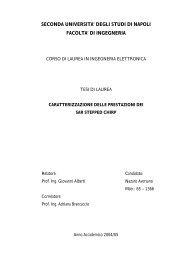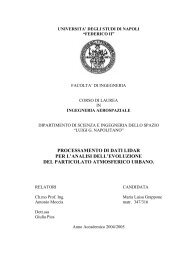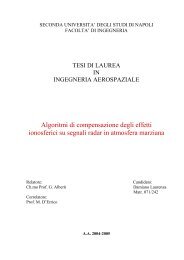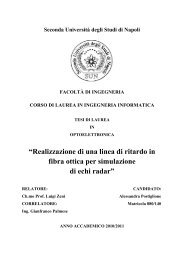Intersatellite link for Earth Observation Satellites ... - CO.RI.STA
Intersatellite link for Earth Observation Satellites ... - CO.RI.STA
Intersatellite link for Earth Observation Satellites ... - CO.RI.STA
You also want an ePaper? Increase the reach of your titles
YUMPU automatically turns print PDFs into web optimized ePapers that Google loves.
<strong>Earth</strong> <strong>Observation</strong><br />
satellite<br />
TLC GEO satellite<br />
SAR<br />
Payload<br />
SAR data<br />
stream<br />
GEO data<br />
relay<br />
OISLs LEO<br />
terminal<br />
Optical<br />
<strong>link</strong><br />
OISLs GEO<br />
terminal<br />
Optical or RF<br />
Link to ground<br />
Figure 6 – System architecture<br />
The present proposal is primarily based on an <strong>Intersatellite</strong> <strong>link</strong> between LEO to GEO satellites, but high data rate<br />
(over 10 Gbps) <strong>link</strong>s between space to ground (optical feeder), although propagation effects due to the atmosphere<br />
and weather make this technique a much more difficult, can be also considered.<br />
VI.<br />
Technological considerations<br />
To use optical <strong>link</strong>s in satellite communication is attractive because of their ability to provide very high speed<br />
communications with data rate on the order of 10 Gbps. The RF <strong>link</strong> is not able to provide such high data rate even<br />
in the millimeter wave region and is difficult to use the frequency bands without any interference. According to the<br />
<strong>link</strong> equation, an optical telescope with an aperture equivalent to that of RF antenna provides tens of db of <strong>link</strong><br />
efficiency improvement. The distance between a LEO satellite and a GEO satellite could be about 45,000 km and an<br />
optical <strong>Intersatellite</strong> <strong>link</strong> requires high power laser devices, high gain optical antenna (telescope) and highly<br />
sensitivity optical detectors. The beam divergence of the laser is typically about 1 – 2 μRad and its footprint on the<br />
<strong>Earth</strong> surface from a distance of 45,000 km is in the order of tens of meter.<br />
Key technologies <strong>for</strong> a such system are the beam acquisition to acquire an incoming laser beam with an accuracy<br />
that permit to initiate a communications <strong>link</strong>, the beam tracking to receive the incoming laser beam with a high<br />
accuracy (better than one μRad) and to maintain the communication <strong>link</strong> and the beam pointing to transmit the laser<br />
beam toward the other satellite and to compensate the relative motion between the two satellite.<br />
Typical target specifications <strong>for</strong> the major onboard components are reported in the following: 1 to 2,5Gbps <strong>for</strong> 1,55<br />
μm wavelength, 15 to 20 cm telescope aperture, typically 100’s mW (less than 10 W peak power) optical power<br />
from laser transmitter, high sensitivity Er-doped fiber amplifier (based on terrestrial fiber optic <strong>link</strong>).<br />
The short emission wavelength allows the use of transmission optics of modest dimension, reducing the mass of the<br />
communication subsystems and there<strong>for</strong>e the mass of the satellite host. As well as reducing the mass, optical<br />
systems have the additional benefit of reducing antenna size (diameters typically are less than 30cm) and the power<br />
consumption of the communication subsystem, created less disturbance to the satellite compared with larger and<br />
heavier RF systems. The narrow beam divergence af<strong>for</strong>d interference-free, low probability of intercept (a very small<br />
area exist where interception of transmitted data is possible) and secure operation.<br />
These optical <strong>link</strong> are important also <strong>for</strong> military applications [Dreisewerd1, Dreisewerd2]. In short, optical<br />
satellite <strong>link</strong> are important whenever high data rates, long <strong>link</strong> distances, and low interference are required. The laser<br />
communication is a point-to-point communication system. The simplest optical communication system is <strong>for</strong>med by<br />
a transmission and a receiver section with the two terminals perfectly aligned on the ground. The high level block<br />
diagram of a typical optical satellite communication payload is showed in Figure 7.<br />
6<br />
American Institute of Aeronautics and Astronautics








